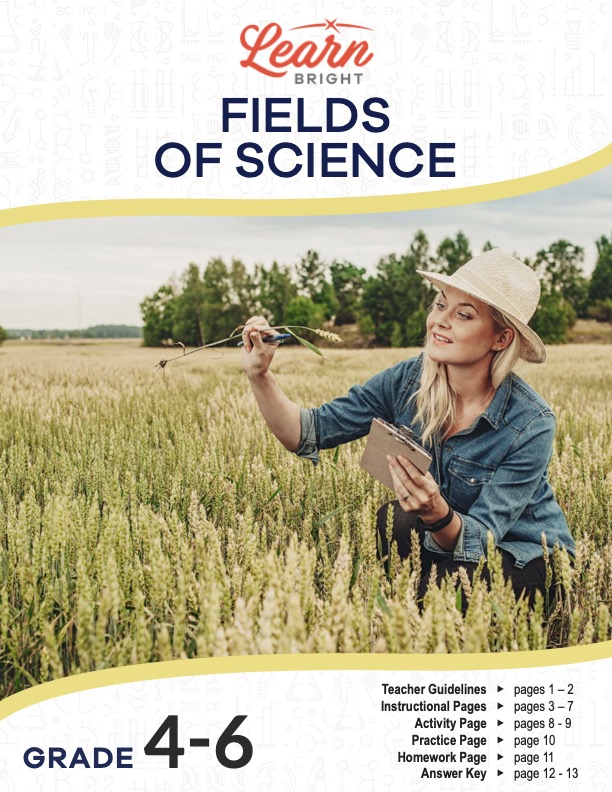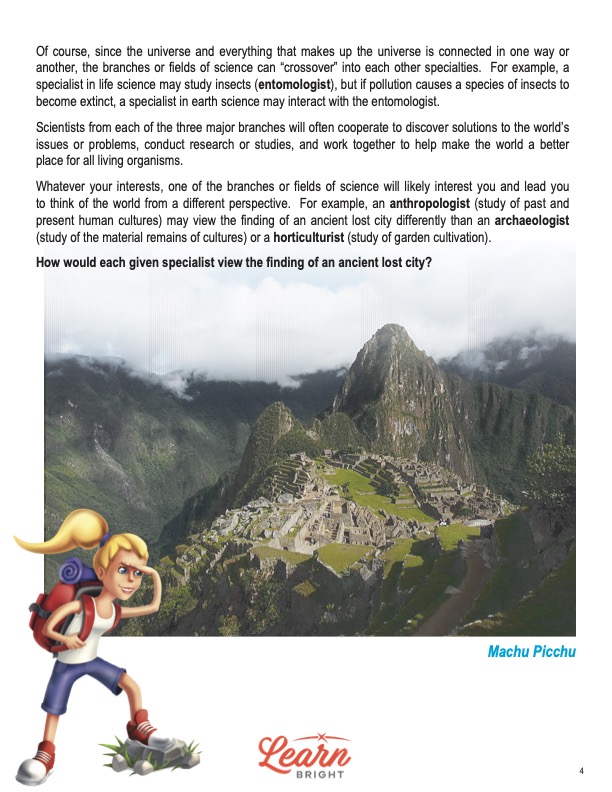Description
What our Fields of Science lesson plan includes
Lesson Objectives and Overview: Fields of Science explores the three main scientific branches and the fields of study within each one. Students will discover facts about specific fields within the physical, earth, and life science branches. They will also learn how to determine what a certain type of science studies based on its Greek or Latin prefixes and suffixes. This lesson is for students in 4th grade, 5th grade, and 6th grade.
Classroom Procedure
Every lesson plan provides you with a classroom procedure page that outlines a step-by-step guide to follow. You do not have to follow the guide exactly. The guide helps you organize the lesson and details when to hand out worksheets. It also lists information in the yellow box that you might find useful. You will find the lesson objectives, state standards, and number of class sessions the lesson should take to complete in this area. In addition, it describes the supplies you will need as well as what and how you need to prepare beforehand. To prepare for this lesson ahead of time, you can gather scissors and containers for each pair of students for the activity.
Options for Lesson
The “Options for Lesson” section of the classroom procedure page lists several suggestions for additional ideas and activities or alternatives that you could incorporate into the lesson. Relating to the activity specifically, students could work alone or in groups rather than with a partner. You could conduct the activity as a classroom exercise as well, possibly with the class divided into two teams. Another option is to assign each student a field or branch of science to research. Students can then present what they find with the class at a later date. You could also invite specialists in each of these fields to speak with the class and discuss their careers and answer students’ questions.
Teacher Notes
The paragraph on this page provides a little more information or guidance on what to expect from the lesson. It explains that this lesson demonstrates how science involves more than information in a textbook. It also suggests you teach this lesson in conjunction with others that relate to the topic. You can use the blank lines to record any thoughts you ideas you have as you prepare.
FIELDS OF SCIENCE LESSON PLAN CONTENT PAGES
Branches of Science
The Fields of Science lesson plan contains five pages of content. The first page explains that there are three major branches in science—physical, earth, and life. It may surprise students to discover that science applies to every aspect of life. After all, a science is simply an organized body of knowledge based on thorough research by many experts over thousands of years. In a broad sense, science is responsible for new discoveries, new knowledge, new inventions, and much more.
Because of innovations in various fields of science, lots of great things have happened. There is new technology, standards of living have improved for many people, and many diseases have been defeated. We have developed helpful medicines and can forecast what the weather will be in the future. With science, understanding and comprehending many things on Earth and throughout the universe is possible.
Science will continue to lead to and provide answers for future issues, dilemmas, diseases, and other difficulties our world faces. As mentioned, there are three major branches of science. Each branch is divided into many other smaller branches or specialized fields of study. Physical sciences relate to the study of inanimate natural objects. Branches of earth science relate to the physical make-up of the Earth and its atmosphere. Finally, life sciences relate to living organisms.
Every field or branch of science relates to one of these major categories. For instance, physical sciences include physics, chemistry, and astronomy. Geology, meteorology, and oceanography are all fields within the greater earth science branch. Life sciences include fields like zoology, biology, and botany.
Examples of Specialized Fields
Because the universe and everything that it is composed of connect in one way or another, fields of science can often cross over into other specialities. For example, a specialist in life science studies insects (an entomologist). If pollution causes a species of insects to die out and become extinct, that person may interact with a specialist in a field of earth science.
Quite often, scientists from all three major branches collaborate to discover solutions to the world’s issues. They frequently conduct research or studies together and work together to help make the world a better place for all living organisms. (This could be a great place to explain that even though people have different interests, they can work together to accomplish mutual goals.)
Students will learn that no matter their interests, one of the branches of science will likely attract them. It may even lead them to think about the world from a different perspective. An anthropologist (someone who studies past and present human cultures), for instance, may view finding an ancient lost city differently than an archaeologist or horticulturist. An archaeologist studies the material remains of cultures. A horticulturist studies garden cultivation. For a class discussion, the lesson asks students how each given specialist might view finding an ancient lost city.
The Fields of Science
The different fields or branches of science fall into either the physical, earth, or life science categories. The lesson provides a list of fields within each of those major groups. Students should note that this list is by no means comprehensive or complete since there are many other fields that are even more specific. For instance, hematology is the study of blood, and hepatology is the study of the liver. Neither is on the list, but they are no less important than those that are.
To help students keep track of which fields fall into which major branch, the lesson provides an easy way to think about it. Students can think of physical science as the study of things that do not live. Branches of earth science involve studying nonliving things on Earth or in the atmosphere. Life sciences relate to studying anything that lives or is connected to something that lives.
For most fields, adding -ist at the end forms the word that describes people who are experts in those fields. An expert in biology, which is the scientific study of life, is called a biologist. Most of the prefixes, suffixes, and roots in names of various fields originate in Latin or Greek. The prefix hydro- means water, and the suffix -ology means the study of. Hydrology is the study of the movement and quality of water on Earth.
At this point, it could be a fun exercise to provide more examples of fields and have students determine what to call the expert. Since some fields do not use the -ist suffix, including those branches in the exercise would provide a fun challenge for students. In addition, having students guess what a field studies based on its prefix could likewise be an interesting challenge.
FIELDS OF SCIENCE LESSON PLAN WORKSHEETS
The Fields of Science lesson plan includes three worksheets: an activity worksheet, a practice worksheet, and a homework assignment. Each one will help students solidify their grasp of the material they learned throughout the lesson. You can refer to the classroom procedure guidelines to know when to hand out each worksheet.
COLLEAGUES IN THE FIELD ACTIVITY WORKSHEET
Students will work with a partner to complete the activity. The worksheet contains a list of a few dozen fields of study in the various branches of science. Students will cut out each field, fold the papers, and place them in a container. They will then take turns picking slips of paper from the container and expressing a statement that a specialist in that field might say to a colleague. You could choose to time the activity or let students go through all the slips of paper.
MATCH THE DEFINITION PRACTICE WORKSHEET
For the practice worksheet, students will review 20 descriptions or statements. Using the terms in the word bank, they will match the description to the correct term. You can choose whether or not you allow students to use the content pages for reference as they complete this assignment.
FIELDS OF SCIENCE HOMEWORK ASSIGNMENT
The homework assignment is divided into three sections. For the first section, students will read ten scenarios and decide which field of science the scenario relates to. The second section requires students to describe what ten different fields study. Finally, students will create three new fields of science. They will use their creativity to come up with a new term and accompanying description.
Worksheet Answer Keys
The last couple pages of the document are answer keys for the practice and homework worksheets. The answers are in red to make it easy for you to compare them to students’ responses. For the most part, students’ answers should reflect the answer keys. However, the final section of the homework worksheet will vary given the nature of the prompts. If you choose to administer the lesson pages to your students via PDF, you will need to save a new file that omits these pages. Otherwise, you can simply print out the applicable pages and keep these as reference for yourself when grading assignments.









